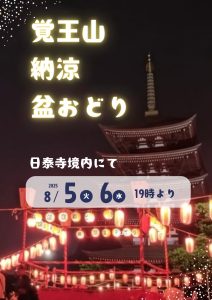覚王山日泰寺 納涼盆おどりが開催されます(愛知県名古屋市千種区姫池通 骨董買取 古美術風光舎)
2025.07.29

8月5日(火)、6日(水)覚王山日泰寺境内にて「納涼盆おどり」が開催されます。
時間は19時からとなっています。
暑い日が続きますが、浴衣に下駄などの涼しい装いで、やぐらを囲んで夢中になって踊れば、ほんのひと時でも暑さを忘れられるのではないでしょうか。提灯のあかりの下、覚王山の五重塔を仰ぎ見ながらの盆踊りはなかなか特別感があります。
覚王山納涼盆踊りは地域の交流の場として、また盂蘭盆会として戦後の復興期より始まったとされています。
現在は地域の団体である「たしろ会」を中心として運営されています。「百まで踊ろう」をモットーに性別や年齢を問わず盆踊りを楽しんでいるとのこと。私も子供の頃、最初は控えめに踊るのですが、徐々にノリノリになってきて、これは永遠に踊れるなと思ったことがあります。脳から何かが出ていたのでしょうか。
盆踊りの踊り方や音頭は地域によって様々で、有名なところでは「東京音頭」や「花笠音頭」、「ソーラン節」や「河内音頭」などがあり、他にもアニメソングや歌謡曲など多岐に渡ります。物静かで控えめだと称される日本人ですが、実は踊るのが大好きな国民性なのではと思います。江戸時代には風紀を乱すとして取り締まりを受けたこともあるようですが、それでも途絶えなかったのですから日本人には無くてはならない行事なのでしょう。
覚王山納涼盆踊りの踊りは豊起枝会という民謡の流れを汲んでいるのだとか。踊り方が分からないと初めは輪の中に入りづらいかもしれませんが、見よう見まねで踊っているうちに何となく踊れてしまうのが盆踊りの素晴らしいところです。完璧に踊る必要はなく、踊ることを楽しんだもの勝ちのような気がします。他の人と踊りを揃えることで次第にヒートアップし、気持ちが解放されていく感覚が盆踊りの醍醐味なのではないでしょうか。
もう何年も盆踊りからは遠ざかっておりますが、ここ数年行きたい気持ちがむくむくと湧いてきている盆踊りがございます。日本三大盆踊りのひとつとされる岐阜県の「郡上おどり」です。
郡上おどりの種類は10種類あり、古調かわさき、かわさき、三百、春駒、ヤッチク、げんげんばらばら、猫の子、甚句、さわぎ、まつさかとなっていて、国の重要無形民俗文化財に指定されおり、またユネスコ無形文化遺産にも登録されています。これらの踊りは少しずつ激しさが増していく順番となっていて長時間踊りを楽しめるように考えられているのだそうです。
それぞれの歌詞に信仰や農作業、男女間の情愛などの意味が込められているそうで、背景を知って踊るとまた違った感覚を味わえるかもしれません。
テレビで観たのですが、特に踊りの上手い人には「免許皆伝」と記した木の札が審査員から渡されるのだそうです。毎晩9時過ぎ頃に課題曲が表示され保存会員による審査が行われ、渡された木の札はあとで免許状と交換してくれるのだとか。免許状は曲ごとにあるそうですが、一つもらったら絶対に全曲制覇したくなるでしょうね。
400年続く郡上おどりは、7月中旬から9月上旬にかけて30夜以上に渡り開催されます。大体夜の8時から10時ころまでですが、お盆の8月13日から16日はいわゆる「徹夜おどり」が行われ、午後8時から翌朝5時まで踊り明かします。地域は踊りの熱気に包まれ、映像で観るだけでも圧巻の景色です。世界的に見てもこのような行事は類を見ないのではないでしょうか。
ぜひ輪の中に入りたい!人生で一度経験してみたいことの一つです。
最近、人生で一度は…と思うことが多くなりました。年齢のせいでしょうか。
それでは、また次の機会に。(スタッフH)
On Tuesday, August 5th and Wednesday, August 6th, the “Noryo Bon Odori” will be held at the grounds of Kakuozan Nittaiji Temple.
The event will begin at 7:00 PM.
Despite the ongoing heatwave, wearing cool attire such as yukata and geta, and dancing enthusiastically around the yagura (stage) may help you forget the heat for a moment. Dancing under the lantern lights while gazing up at the five-story pagoda of Kakuzan Temple creates a truly special atmosphere.
The Kakuzan Summer Bon Odori is said to have begun during the post-war reconstruction period as a community gathering and as part of the Obon festival.
Currently, it is organized by the local group “Tashiro-kai.” With the motto “Dance until you’re 100,” people of all genders and ages enjoy the Bon dance. When I was a child, I started dancing cautiously at first, but gradually got into the groove and thought, “I could dance forever.” Was something coming out of my brain?
The dance styles and chants of Bon Odori vary by region, with famous examples including “Tokyo Ondo,” “Hanagasa Ondo,” “Soran Bushi,” and “Kawachi Ondo,” as well as anime songs and enka ballads. Despite being described as quiet and reserved, I think the Japanese people actually have a national love for dancing. Although it was once banned during the Edo period for allegedly disrupting public order, it never ceased to exist, so it must be an indispensable event for the Japanese people.
The dance at the Kakuyama Summer Bon Odori is said to be rooted in the folk song tradition of the Toyoki-e Association. At first, it may be difficult to join the circle if you don’t know the dance steps, but the wonderful thing about Bon Odori is that you can somehow manage to dance along by watching and imitating others. There’s no need to dance perfectly; it’s more about enjoying the dance. As you synchronize your movements with others, the energy builds up, and the sense of liberation is what makes Bon Odori so special.
I haven’t attended a Bon Odori in years, but there’s one I’ve been eager to attend in recent years: the Gujo Odori in Gifu Prefecture, one of Japan’s three major Bon Odori festivals.
There are ten types of Gujo Odori dances: Kucho Kawazaki, Kawazaki, Sanbyaku, Harukoma, Yatchiku, Gengenbarabara, Neko no Ko, Jinju, Sawagi, and Matsusaka. These dances are designated as Important Intangible Folk Cultural Properties of Japan and are also registered as UNESCO Intangible Cultural Heritage. These dances are arranged in order of increasing intensity, designed to allow dancers to enjoy dancing for extended periods.
Each song’s lyrics are said to contain meanings related to faith, agricultural work, and romantic love between men and women. Understanding the background may offer a different perspective when dancing.
I saw it on TV, but apparently, those who dance exceptionally well are given a wooden plaque inscribed with “license granted” by the judges. Every night around 9 PM, the theme song is displayed, and a review is conducted by preservation society members. The wooden plaque is later exchanged for a license certificate. Apparently, there is a license certificate for each song, but once you receive one, you’ll probably want to conquer all the songs.
The Gujo Odori, which has been held for over 400 years, takes place from mid-July to early September over more than 30 nights. It generally runs from 8 PM to 10 PM, but during the Obon period from August 13 to 16, there is an all-night dance event where people dance from 8 PM until 5 AM the next morning. The region is enveloped in the fervor of the dance, and even watching it on video is an awe-inspiring sight. Such an event is probably unparalleled worldwide.
I really want to join in! It’s one of those things I’d like to experience at least once in my life.
Recently, I’ve been thinking more often that I want to do something once in my life. Maybe it’s because of my age.
Well, see you next time. (Staff H)
*******************
ご実家の整理やお片付けなどをされている方のご相談などが多くございます。
お片付けなどくれぐれもご無理のないようになさってくださいませ。
風光舎では古美術品や骨董品の他にも絵画や宝石、趣味のお品など様々なジャンルのものを買受しております。
お片付けをされていて、こういうものでもいいのかしらと迷われているものでも、どうぞお気軽にご相談下さいませ。
また風光舎は、出張買取も強化しております。ご近所はもちろん、愛知県内、岐阜県、三重県その他の県へも出張いたします。
まずは、お電話お待ちしております。
愛知県名古屋市千種区姫池通
骨董 買取【古美術 風光舎 名古屋店】
TEL052(734)8444
10:00-18:00 OPEN

